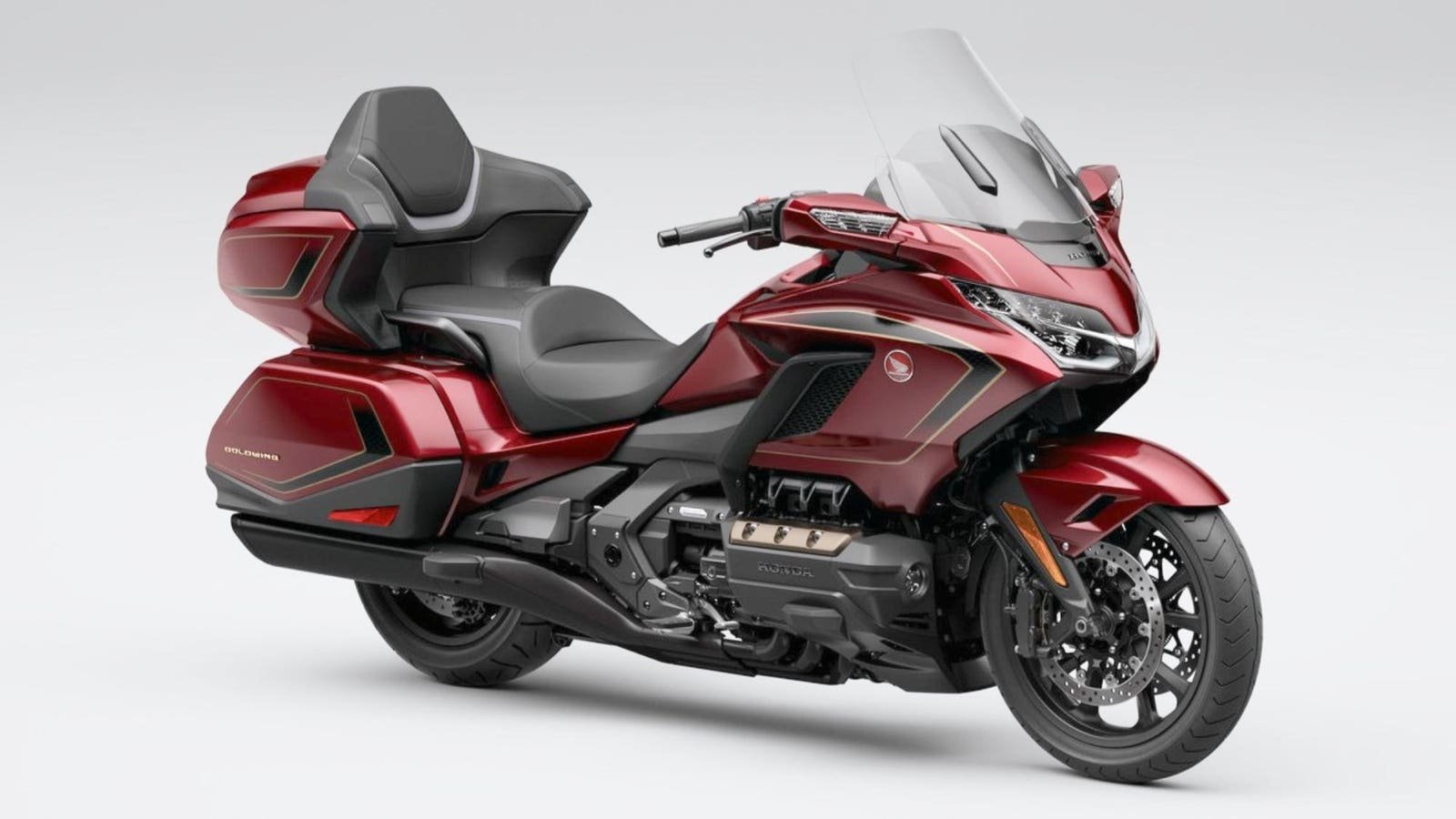Fifty years after it debuted, the Honda Gold Wing remains a top choice for long-distance travel by … [+]
For many enthusiasts, 1975 was a great year for motorcycles, and it was also the heart of a defining era for the industry overall. Some call the years between 1969 and 1983 the “golden age of motorcycling,” while others regard it (perhaps with some sadness) as a rapid transition from the “vintage” era of British and American market dominance to the “modern” era of Asian and European technological supremacy. I guess it depends on what you were riding at the time.
A Golden Age Start For The Gold Wing
Honda kicked off the modern mass-market motorcycle revolution with its groundbreaking (and race bike-derived) 1969 CB750, which featured an inline-four motor, front disc brake, electric start, four carburetors and a high level of fit, finish, and reliability. There were some small-batch exotics with those features at the time, but no one had ever seen an affordable mass-production motorcycle like the CB750 before, and everyone began trying to hit the high bar set by the seminal Honda.
In just a few short years, the worldwide motorcycle industry was completely changed by the CB750 and the machines made to compete with it, and the fallout from the CB750 quickly lifted the Japanese motorcycle makers to prominence while legacy motorcycle makers – Norton, BSA, Triumph, BMW, Harley-Davidson and many others – either vanished from the market or struggled to adapt and survive. And Soichiro Honda wasn’t even close to being finished shocking the marketplace.
The original 1975 Honda Gold Wing wasn’t designed as a tour bike – it was the high-tech, hot-rod … [+]
Honda debuted the GL1000 Gold Wing (above) in 1975. It was an uncharacteristic “big bike” that, to Honda, superseded the CB750 as the next generation of high-performance Honda motorcycles. It wasn’t the Goldwing we know today with saddlebags, a large windscreen, stereo and so forth – it was a “regular” unadorned motorcycle, albeit a large one.
The technological shadow of the CB750 still loomed large over the industry in terms of speed and sophistication, but other brands were beginning to catch up to it – or surpass it. The Gold Wing was Honda’s “answer” to those challengers. It included a flat opposed-four pancake motor not unlike what was found in the back of a Volkswagen car, except the Honda’s compact, quad-carbureted liquid-cooled 1,000cc engine made nearly double the horsepower—78 as measured at the time—in a motorcycle chassis rather than a heavy car. It also had a lot of torque thanks to the long-stroke “boxer” engine.
More new features included Honda’s first shaft drive system, much like the BMWs of the time, for low maintenance and quiet operation. Gas didn’t go in the traditional spot, it was stored under the seat. The fake “gas tank” had small cubbies for gloves, snacks, tools and so forth. The low-set gas tank coupled with the low position of the heavy engine made the early Gold Wings unexpectedly agile. Gold Wing performance was… robust. Triple disc brakes – almost unheard of at the time – enabled aggressive stopping power. It was fast, reliable, quiet and above all, comfortable. Here’s a quick overview and ride aboard a 1976 model at the Honda Collection Hall museum in Motegi, Japan:
But then, thousands of riders (mostly Americans) who snapped up the Gold Wing began adding windscreens, panniers/saddlebags, backrests, and more, quickly growing an enormous aftermarket industry around touring on the Gold Wing – not winning drag races.
Large aerodynamic windscreens and other touring bits from designer and industry icon Craig Vetter and others dressed up the basic Gold Wing for long-haul comfort. Touring clubs, rallies and owners groups sprang up worldwide. The Gold Wing developed a reputation as a dependable high-mileage tourer, with many riders handily topping 100,000 miles with regular upkeep. Many Gold Wing models from early production years continue to be ridden today.
By the early 1980s, the Honda Gold Wing had become the factory turn-key touring platform we are now … [+]
Honda took notice and adjusted course, and by 1984, the Gold Wing had grown to 1,200cc and could come fully clothed from the factory for long-distance riding in “Aspencade” trim (above), with an adjustable windscreen, voluminous carry capacity, a stereo system, CB Radio, intercom, adjustable suspension, fuel injection in 1985 and passenger accommodations par excellence. In 1987, the flat four became a flat six, and remains so today while growing to 1,833 cc’s of displacement – nearly double the original’s.
Over the past 50 years, improvements to the Gold Wing have been both incremental and fundamental, but always consistent. Lately, Honda began easing the Gold Wing away from the “luxury sled” niche towards the “more sporty luxury tourer” with a novel front suspension, less bulk and sharpened handling and performance – even a ”bagger” version. Honda has also been adding every tech safety feature in their considerable arsenal – including an airbag for the rider on the top model, the only motorcycle to offer the supplemental restraint.
Fifty Years Of Open Road Riding
The 2025 Honda Gold Wing in, appropriately, Eternal Gold.
For the Gold Wing’s 50th birthday, Honda has released a slate of anniversary models with special features, livery and some exclusivity. The model is mechanically identical to the 2024 machines, which is a good thing. But Honda has added 50th anniversary color schemes – including the red call back to the original in the top photo – along with badging and some additional features to commemorate a half century of Gold Wing goodness.
Honda offers the Gold Wing in various trim options, from $25,000 to $33,500 with all the goodies, … [+]
The 2025 Honda Gold Wing 50th anniversary models retain the flat opposed six-cylinder engine and it’s fully up to date, with fuel injection, four valves per cylinder, and the trick double-wishbone front suspension. There are ride modes, throttle-by-wire, traction control, ABS, LED lighting, phone integration, a 7-speed automatic transmission on some trims, a reverse gear and yes, you can still get one with an airbag for added safety.
Got stuff to bring along – and a passenger? Few motorcycles can handle a heavy load plus a passenger … [+]
Pricing for the 2025 Honda Gold Wing begins at $25,200 and rises to $33,500 with all the goodies (and the airbag), but the engine, frame and other basics are the same for each model. I’ve owned two Gold Wings myself, a 1976 and a 1981 model, and I’m hoping to get some seat time on the 2025 Gold Wing once the weather warms up a bit. Subscribe and check back for a review.
Thank you for reading. Subscribing to Forbes.com allows you to leave comments and support contributors like myself. Subscribe to my Forbes.com page and get notifications when new stories are posted. You can also follow me on LinkedIn.







